Original Source
..
Anthropic Principle
Doctor James Schombert
Lecture #28, June 2, 2004
Physics Department
University of Oregon
..
Anthropic
Principle :
The success of science in understanding the macroscopic, microscopic and
cosmological worlds has led to the strong belief that it is possible to form a
fully scientific explanation of any feature of the Universe. However, in the
past 20 years our understanding of physics and biology has noted a peculiar
specialness to our Universe, a specialness with regard to the existence of
intelligent life. This sends up warning signs from the Copernican Principle, the
idea that no scientific theory should invoke a special place or aspect to
humans.
..
All the laws of Nature have particular constants associated with them, the
gravitational constant, the speed of light, the electric charge, the mass of the
electron, Planck's constant from quantum mechanics. Some are derived from
physical laws (the speed of light, for example, comes from Maxwell's equations).
However, for most, their values are arbitrary. The laws would still operate if
the constants had different values, although the resulting interactions would be
radically different.
..
- gravitational constant: Determines strength of gravity. If lower than
stars would have insufficient pressure to overcome Coulomb barrier to start
thermonuclear fusion (i.e. stars would not shine). If higher, stars burn too
fast, use up fuel before life has a chance to evolve.
- strong force coupling constant: Holds particles together in nucleus of
atom. If weaker than multi-proton particles would not hold together, hydrogen
would be the only element in the Universe. If stronger, all elements lighter
than iron would be rare. Also radioactive decay would be less, which heats
core of Earth.
- electromagnetic coupling constant: Determines strength of electromagnetic
force that couples electrons to nucleus. If less, than no electrons held in
orbit. If stronger, electrons will not bond with other atoms. Either way, no
molecules.
..
All the above constants are critical to the formation of the basic building
blocks of life. And, the range of possible values for these constants is very
narrow, only about 1 to 5% for the combination of constants. Outside this range,
and life (in particular, intelligent life) would be impossible.
..
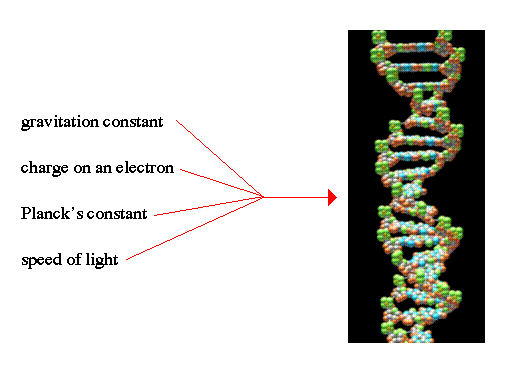
..
It is therefore possible to imagine whole different kinds of universes with
different constants, all equally
valid within the laws of Nature. For example, a
universe with a lower gravitational constant would have a weaker force of
gravity, where stars and planets might not form. Or a universe with a high
strong force which would inhibit thermonuclear fusion, which would make the
luminosity of stars be much lower, a darker universe, and life would have to
evolve without sunlight. Why don't those Universes exist? Why does our Universe,
with its special value exist rather than another? Is there something fundamental
to our physics that makes the present values for physical constants expected?
..
Cosmological Constants:
The situation became worst with the cosmological discoveries of the 1980's.
The two key cosmological parameters are the cosmic expansion rate (Hubble's
constant, which determines the age of the Universe) and the cosmic density
parameter ( ), which determines the acceleration of
the Universe and its geometry).
), which determines the acceleration of
the Universe and its geometry).
..
The cosmic density parameter determines the three possible shapes to the
Universe; a flat Universe (Euclidean or zero curvature), a spherical or closed
Universe (positive curvature) or a hyperbolic or open Universe (negative
curvature). Note that this curvature is similar to spacetime curvature due to
stellar masses except that the entire mass of the Universe determines the
curvature.
..
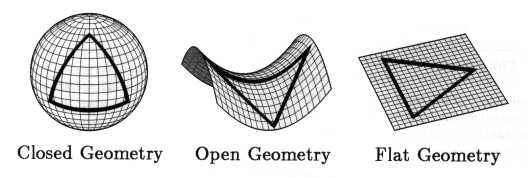
..
The description of the various geometries of the Universe (open, closed,
flat) also relate to their futures. There are two possible futures for our
Universe, continual expansion (open and flat) or turn-around and collapse
(closed). Note that flat is the specific case of expansion to zero velocity.
..
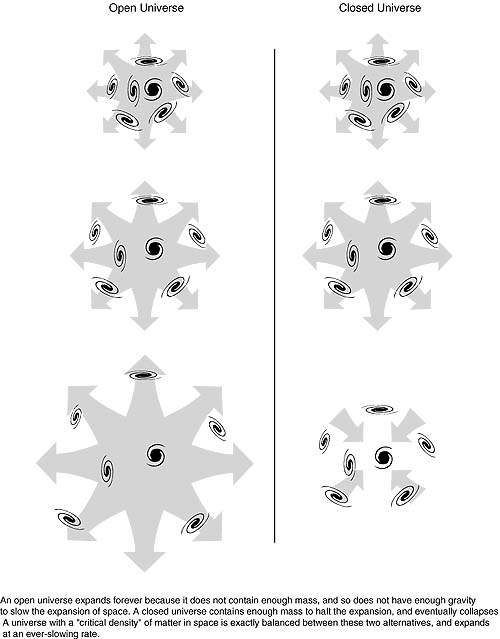
..
Current values for the critical density range from 0.1 to 1, which produces a
new dilemma from modern cosmology, the flatness problem.
..
The flatness problem relates to the density parameter of the Universe,
 . Values for
. Values for
 can take on
any number, but it has to be between 0.01 and 5. If
can take on
any number, but it has to be between 0.01 and 5. If  is more than 0.01 the Universe is expanding so fast
that the Solar System flys apart. And
is more than 0.01 the Universe is expanding so fast
that the Solar System flys apart. And  has to be
less than 5 or the Universe is younger than the oldest rocks. The measured value
is near 0.2. This is close to an
has to be
less than 5 or the Universe is younger than the oldest rocks. The measured value
is near 0.2. This is close to an  of 1, which is
strange because
of 1, which is
strange because  of 1 is an unstable critical
point for the geometry of the Universe.
of 1 is an unstable critical
point for the geometry of the Universe.
..
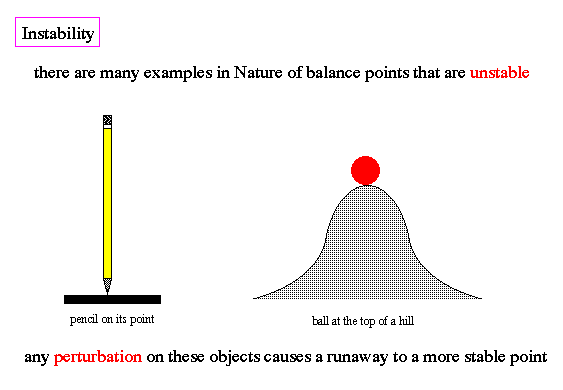
..
Values slightly below or above 1 in the early Universe rapidly grow to much
less than 1 or much larger than 1 (like a ball at the top of a hill). So the
fact that the measured value of 0.2 is so close to 1 that we expect to find in
the future that our measured value is too low and that the Universe has a value
of  exactly equal to 1 for stability.
exactly equal to 1 for stability.
..
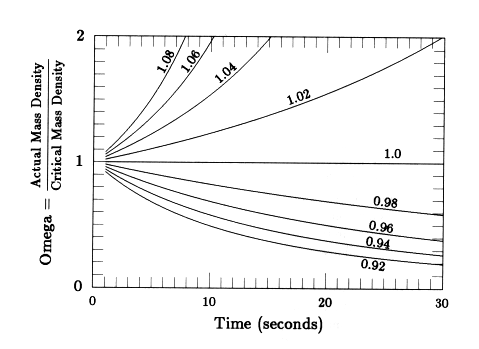
..
And therefore, the flatness problem is that some mechanism is needed to get a
value for  to be very, very close to one (within
one part in a billion billion).
to be very, very close to one (within
one part in a billion billion).
..
Anthropic Principle:
So the philosophical dilemma is that the constants of the Universe on a
microscopic (atomic constants), macroscopic (electromagnetic forces) and
cosmological levels all appear to be extremely fine-tuned in order for life and
intelligence to evolve.
..
This concern of how conscious creatures, such as ourselves, came to be in the
Universe is called the anthropic principle, and has three forms; weak, strong
and final.
..
Weak Anthropic Principle: The observed values of all physical and
cosmological quantities are not equally probable but they take on values
restricted by the requirement that there exist sites where carbon-based life can
evolve and by the requirements that the Universe be old enough for it to have
already done so.
..
Strong Anthropic Principle: The Universe must have those properties which
allow life to develop within it at some stage in its history. Because:
..
- There exists one possible Universe `designed' with
the goal of generating and sustaining `observers'. or...
- Observers are necessary to bring the Universe into being (participatory
universe). or...
- An ensemble of other different universes is necessary for the existence of
our Universe
..
Final Anthropic Principle: Intelligent information-processing must come into
existence in the Universe, and, once it comes into existence, it will never die
out.
..
The weak version of the anthropic principle just says that our existence
allows us to infer values of certain fundamental constants. Our existence is an
indicator of what values these constants have. But the strong version claims not
just that our existence allows us to infer the values of the constants, but that
it is moreover the explanation of why they have just the values that they do.
..
Anthropic Principle and Circular Reasoning :
The usual criticism of any form of the anthropic principle is that it is
guilty of a tautology or circular
reasoning.
..
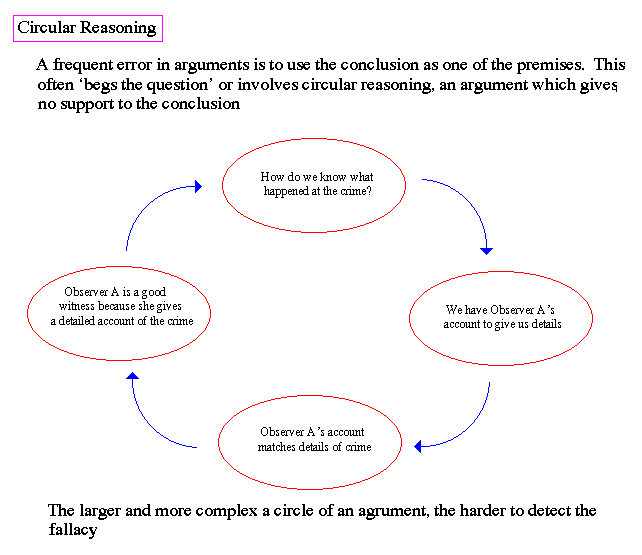
..
With the respect to our existence and the Universe, the error in reasoning is
that because we are here, it must be possible that we can be here. In other
words, we exist to ask the question of the anthropic principle. If we didn't
exist then the question could not be asked. So there is nothing special to the
anthropic principle, it simply states we exist to ask questions about the
Universe.
..
An example of this style of question is whether life is unique to the Earth.
There are many special qualities to the Earth (proper mass, distance from Sun
for liquid water, position in Galaxy for heavy elements from nearby supernova
explosion). But, none of these characteristics are unique to the Earth. There
may exists hundreds to thousands of solar systems with similar characteristics
where life would be possible, if not inevitable. We simply live on one of them,
and we would not be capable of living on any other world.
..
This solution is mildly unsatisfying with respect to physical constants since
it implies some sort-of lottery system for the existence of life, and we have no
evidence of previous Universes.
..
Anthropic Principle and Many-Worlds Hypothesis:
Another solution to the anthropic principle is that all possible universes
that can be imagined under the current laws of Nature are possible, and do have
an existence as superpositions.
..
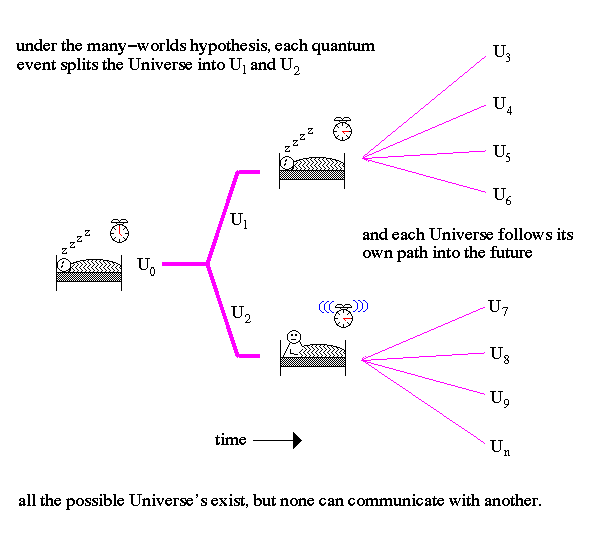
..
This is the infamous many-worlds hypothesis used to explain how the position
of an electron can be fuzzy or uncertainty. Its not uncertain, it actual exists
in all possible positions, each one having its own separate and unique universe.
Quantum reality is explained by the using of infinite numbers of
universes where every possible realization of position and energy of every
particle actually exists.
..
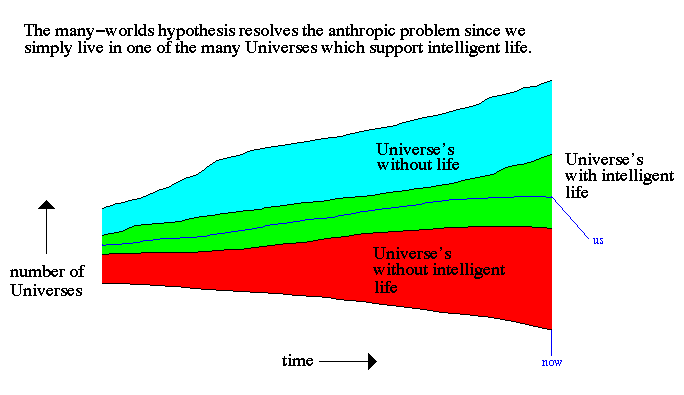
..
With respect to the anthropic principle, we simply exist in one of the many
universes where intelligent life is possible and did evolve. There are many
other universes where this is not the case, existing side by side with us in
some super-reality of the many-worlds. Since the many-worlds hypothesis lacks
the ability to test the existence of these other universes, it is not
falsifiable and, therefore, borders on pseudo-science.
..
Anthropic Principle and Inflation :
The solution to the anthropic principle appears to lie in the very early
Universe, moments after the Big Bang, the inflation era. Our old view of the
Universe was one of newtonian expansion, at less than the speed of light.
..
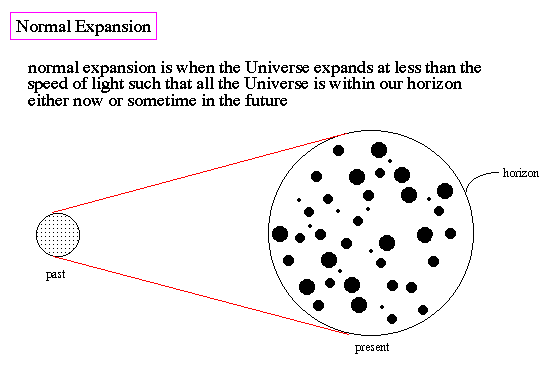
..
However, now we know that, because of symmetry breaking at the GUT
unification point, spacetime and matter separated and a tremendous amount of
energy was released. This energy produced an overpressure that was applied not
to the particles of matter, but to spacetime itself. Basically, the particles
stood still as the space between them expanded at an exponential rate.
..
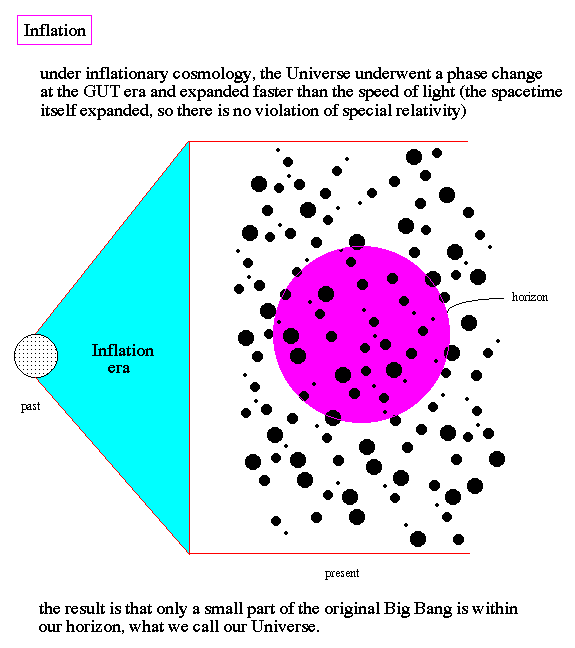
..
During inflation, the Universe expanded a factor of 1054, so that our horizon now only sees a small piece of what
was the total Universe from the Big Bang.
..
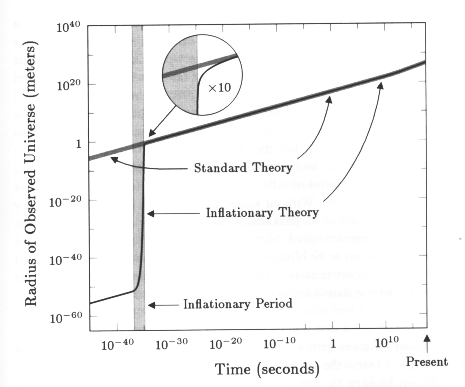
..
Our visible Universe, the part of the Big Bang within our horizon, is
effectively a `bubble' on the larger Universe. However, those other bubbles are
not physically real since they are outside our horizon. We can only relate to
them in an imaginary, theoretical sense. They are outside our horizon and we
will never be able to communicate with those other bubble universes.
..
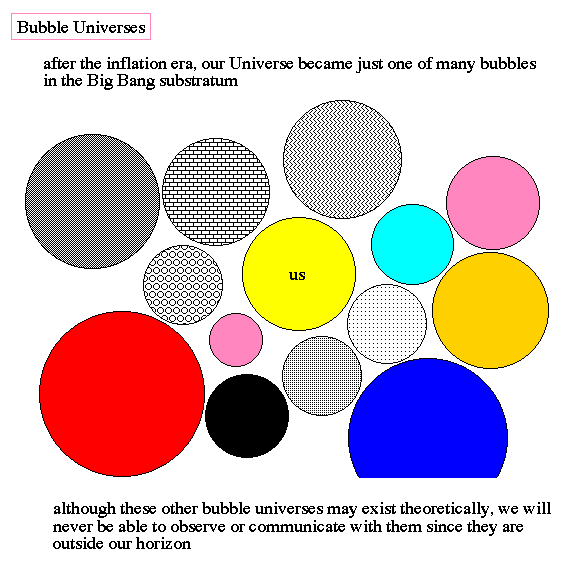
..
Inflation's answer to the anthropic principle of any form is that many bubble
universes were created from the Big Bang. Our Universe had the appropriate
physical constants that lead to the evolution of intelligent life. However, that
evolution was not determined or required. There may exist many other universes
with similar conditions, but where the emergent property of life or intelligence
did not develop.
..
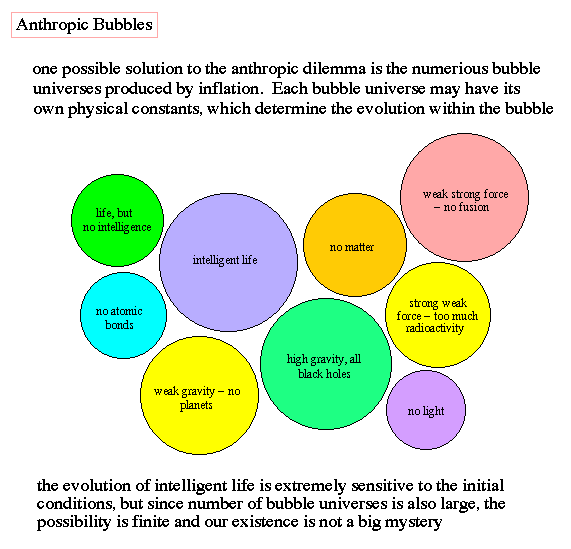
..
Hopefully a complete Theory of Everything will resolve the `how' questions on
the origin of physical constants. But a complete physical theory may be lacking
the answers to `why' questions, which is one of the reasons that modern science
is in a crisis phase of development, our ability to understand `how' has
outpaced our ability to answer if we `should'.
..
Origin of
Life:
..
The Earth's crust became stable about 3.9 billion years ago. Life appeared
around 3.6 to 3.9 billion years ago, which is quite fast in astronomical terms.
Microfossils found in ancient rocks from Australia and South Africa demonstrate
that terrestrial life flourished by 3.5 billion years ago. Older rocks from
Greenland, 3.9 billion years old, contain isotopic carbon, carbon that could
only have belonged to a living organism. The early atmosphere of the Earth was a
secondary atmosphere from volcanic outgassing, very CO2-rich with little free O2.
..
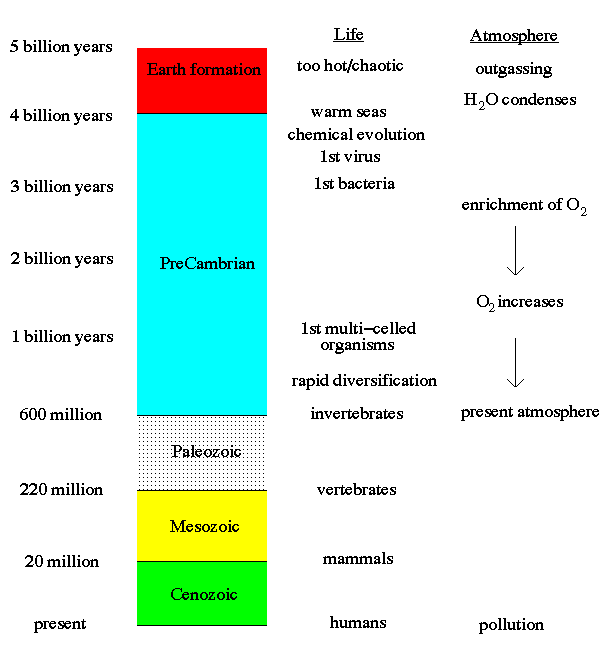
..
The Earth lies at the correct distance from the Sun for liquid water
to exist. The evolution of
life requires two elements; energy and a medium for growth. Sunlight serves
as the source of energy for most life (a counter-example is bacteria that grows
on the ocean trenches powered by heat from thermal vents). Sunlight provides the
energy needed for food manufacture (biochemical energy storage) and molecular
construction (genetic material, cell walls, etc.). Indirectly, sunlight provides
a warm temperature, which means higher chemical reaction rates for simple life.
More complex life requires sunlight for vision and a stable environment.
..
Chemical Evolution:
Liquid water provides a universal solvent and warm environment for chemical
evolution. It is a vehicle for dissolved substances (it circulates). And it
provides the raw material for protein construction.
..
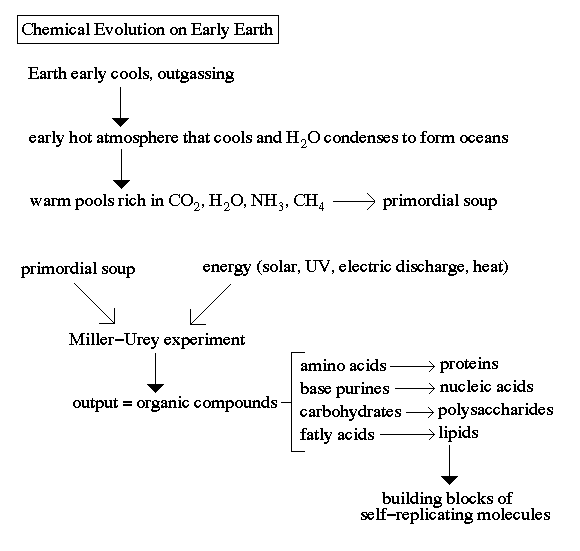
..
When the primordial soup is exposed to energy, organic compounds are
produced as shown by the Miller-Urey
Experiment.
..
Amino
acids are small, highly reactive molecules composed of 20 to 30 HCNO atoms.
When amino acids link together in strings they form proteins.
Proteins govern chemical reaction rates and form the structural material for
cell parts.
..
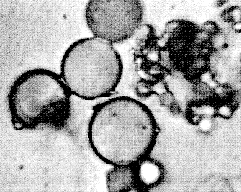
..
Most importantly, they can form into microspheres when heated, which
serves to separate chemical reactions and processes. The problem is that with
the vastness of the Earth's oceans it is statistically very improbable that
these early proteins would ever link up. The solution is that the huge tides
from the Moon produced inland tidal pools, which would fill and evaporate on a
regular basis to produce high concentrations of amino acids, who then linked
themselves into macromolecules.
..
With the construction of large macromolecules, such as proteins and nucleic
acids, the Earth is poised for the next stage of biochemical
evolution. Living organisms are the supreme example of active matter. They
represent the most developed form of organized matter and energy that we know.
They exemplify growth, adaptation, complexity, unfolding form variety and
unpredictability. Almost appearing to be a class apart from matter and energy,
defying the laws that enslave normal matter and energy.
..
Every organism is unique, both in form and development. Unlike physics where
one studies classes of identical objects (e.g. electrons, photons), organisms
are all individuals. Moreover, collections of organisms are unique, species are
unique, the evolutionary history of the Earth is unique, the entire biosphere is
unique. On the other hand, a cat is a cat, a cell is a cell, there are definite
regularities and distinguishing features that permit organisms to be classified.
..
Each level of biology has new and unexpected qualities, qualities which
cannot be reduced to the properties of the component parts, this is known as
holism. A living organism consists of a large range of components differing
greatly in structure and function (heart, liver, hair). Yet, the components are
arranged and behave in a coherent and cooperative fashion as though to a common
agreed plan. This endows the organism with a discrete identity, makes a worm a
worm, a dog a dog.
..
No living thing exits in isolation. All organisms are strongly coupled to
their inanimate environment and require a continual throughput of matter and
energy as well as the ability to export entropy. From a physical and chemical
point of view, every organism is strongly out of equilibrium with its
environment. In addition, life on Earth is an intricate network of mutually
interdependent organisms held in a state of dynamic balance. The concept of
life is fully meaningful only in the context of the entire biosphere.
..
A large number of complex chemical reactions is the underlying process that
we call life. The
ingredients for life are:
..
- energy source
- supply of nutrients (building blocks)
- self-regulating mechanisms
..
The first two criteria were supplied by
the conditions of the early Earth environment. The third criteria was presented
by the endpoint of chemical evolution where the long chains of nucleic acids
were formed which developed into RNA and DNA.
..
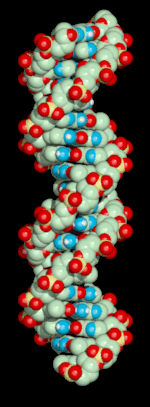
..
RNA and DNA are molecular codes for the production of proteins. They have the
unique property of being self-replicating (when an RNA molecule splits, amino
acids connect to the endpoints producing an exact copy of the original chain).
The beginning of biochemical evolution was when RNA and DNA evolved to coat
themselves in protein shells. These coated RNA and DNA packages are called a virus. A virus is
halfway between life and non-life, being non-living when in isolation, but
adapting living characteristics in interaction with other virus' or cells.
..
The next stage in biochemical evolution was for various virus' to take on
specialized tasks (energy production, protein production, etc). These individual
elements would combine to form the first cell. Our earliest evidence of cellular
life comes from fossil bacteria.
..

..
With the development of cells, life took on an explosive evolution into more
diverse forms, invading new environments (sea, lakes, land).
..
Photosynthesis:
Oxygen is a very small component to outgassing on the Earth, yet O2 is a significant fraction of our current atmosphere
(thank goodness). Also note that O2 is highly
reactive and combines quickly with rock and soil to form oxides (rust). Thus,
the current amount O2 requires a constant
process of replenishment. That process is photosynthesis.
..
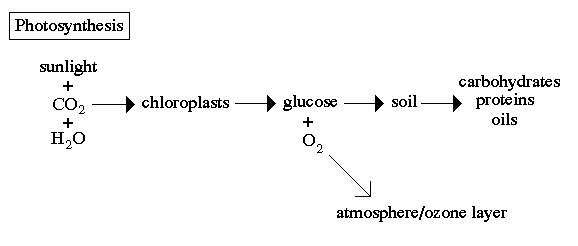
..
The first photosynthesizing organisms used UV light as an energy
source since there is more energy associated with short wavelength light than
long wavelength light (want proof? leave your shirt off for an hour at the
beach). This occurred about 3.5 billion years ago and the immediate by-product
was the ozone layer, which blocks UV light. This resulted in the first mass
extinction, the death of all UV photosynthesizing cells. Only organisms which
were able to utilize the visible portion of the spectrum survived = green plants
and plankton.




 ), which determines the acceleration of
the Universe and its geometry).
), which determines the acceleration of
the Universe and its geometry).


 . Values for
. Values for
 can take on
any number, but it has to be between 0.01 and 5. If
can take on
any number, but it has to be between 0.01 and 5. If  is more than 0.01 the Universe is expanding so fast
that the Solar System flys apart. And
is more than 0.01 the Universe is expanding so fast
that the Solar System flys apart. And  has to be
less than 5 or the Universe is younger than the oldest rocks. The measured value
is near 0.2. This is close to an
has to be
less than 5 or the Universe is younger than the oldest rocks. The measured value
is near 0.2. This is close to an  of 1, which is
strange because
of 1, which is
strange because  of 1 is an unstable critical
point for the geometry of the Universe.
of 1 is an unstable critical
point for the geometry of the Universe.

 exactly equal to 1 for stability.
exactly equal to 1 for stability.

 to be very, very close to one (within
one part in a billion billion).
to be very, very close to one (within
one part in a billion billion).













